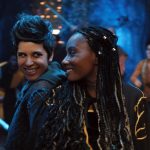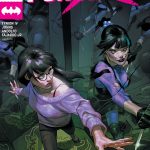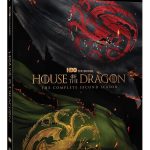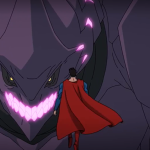Counting Beans: Power, Mental Health, and Queerness in “Disenchantment” Part 4
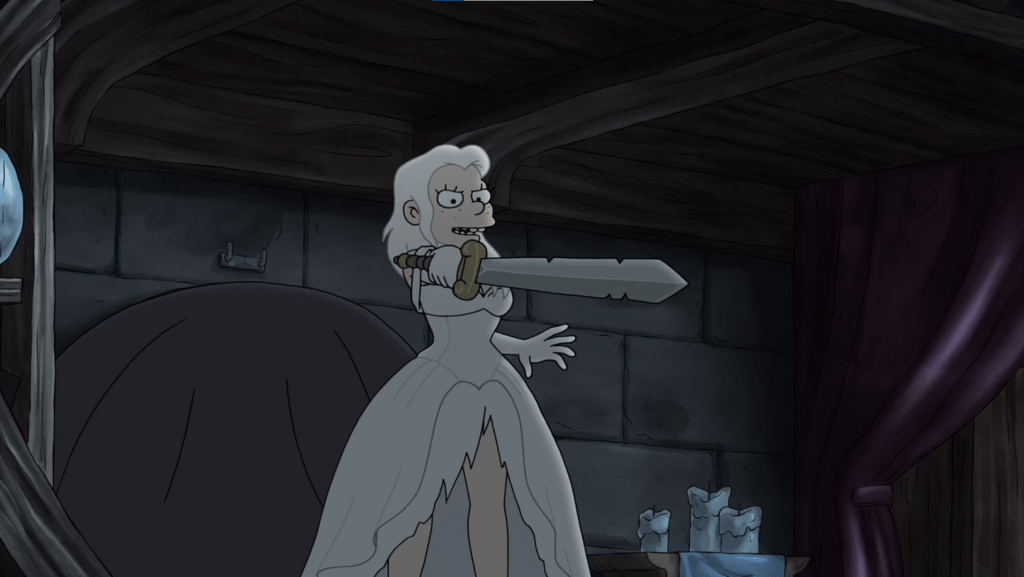
On February 9, the ten episodes of Disenchantment‘s Part 4 aired on Netflix. It continues the story of Bean, a fearless Princess, attempting to return to her homeland, Dreamland. She hopes to reclaim the throne but faces internal and external challenges which prevent her from completing this quest.
Disenchantment is an animated fantasy, sitcom, adventure, and satire, by Matt Groening. He is best known for his long-running animated sitcom, The Simpsons, and his late animated sci-fi comedy-drama, Futurama. Groening is the series showrunner along with Josh Weinstein and Claudia Katz. Eric Horsted, Bill Oakley, and Patric V. Verrone are co-executive producers.
As a warning, this review discusses some spoilers for Disenchantment. It will also discuss topics such as death, blood, murder, trauma, sexual intercourse, and mental health.
Part 4 of Disenchantment begins with Dagmar (Sharon Horgan) kidnapping her daughter, Princess Bean (Abbi Jacobson). Dagmar tries to force her to marry the King of Hell, Satan (Rich Fulcher), in an attempt to “seal the deal” between Bean’s homeland, Dreamland, and Hell. Bean’s friend, Luci (Eric Andre), tries to leave Heaven. Elfo (Nat Faxon) tries to escape the ogres who have captured him.
Luci and Jerry (David Herman) help Bean flee Hell. They are able to commandeer an airship en route to Dreamland. On the way, they rescue Elfo. Once back in Dreamland, they discover that Bean’s devious cousins, aunt Becky (Lucy Montgomery) and uncle Cloyd (Fulcher), are ruling Dreamland. Later, agreement Bean and her dad, Zog (John DiMaggio), agree to share power in Dreamland. Becky, Cloyd, and their newfound puppet friend, Freckles (DiMaggio), try to manipulate whoever they can to gain power. Bean tries to be a better ruler. She has recurring nightmares and faces Satan and Dagmar. The latter pushes Bean into the water and seizes control of the throne.
The series maintains its “good rhythm.” It has occasional humor, like a recurring joke where Luci loses his head, and has to put it back on. There are twisted plots, occasional nudity, smoking, and drinking, mainly by Bean. This is so important to her character that when she drinks less, her friends Luci and Elfo get worried.
Throughout the series, there are bloody scenes and casual violence. Characters injure each other with swords, spears, and other weapons. Some are even eaten by worms. The level of violence is akin to the violence in Inside Job.
Power, authority, manipulation, and exploitation
There is the continual struggle for power and authority in Disenchantment. Cloyd and Becky engage in human experimentation to create their own goons. They also try and manipulate anyone to complete their goals. After their reported defeat, Bean and Zog agree to rule together. Both face an evil puppet named Freckles who works for Becky and Cloyd.
Later, Bean tries to give back and let people come to her in hopes of solving their problems. This is akin to what Rapunzel sings about in a Season 1 episode of Rapunzel’s Tangled Adventure. In the case of Bean, it doesn’t work out, and she ends up getting exhausted.
Freckles becomes one of the most evil characters of the series. After Sorcerio brings him “back to life,” in an homage to Frankenstein, he tries to manipulate Zog. He has more success with Jasper and Derek (voiced by Tress MacNeille), teaching them to fight dirty. As a result, Derek ends up killing one of the bullies by accident. He feels bad about this and goes with Jasper and Derek, leaving town. Before they leave, Freckles visits the bullies and he reveals that he had staged the fight.
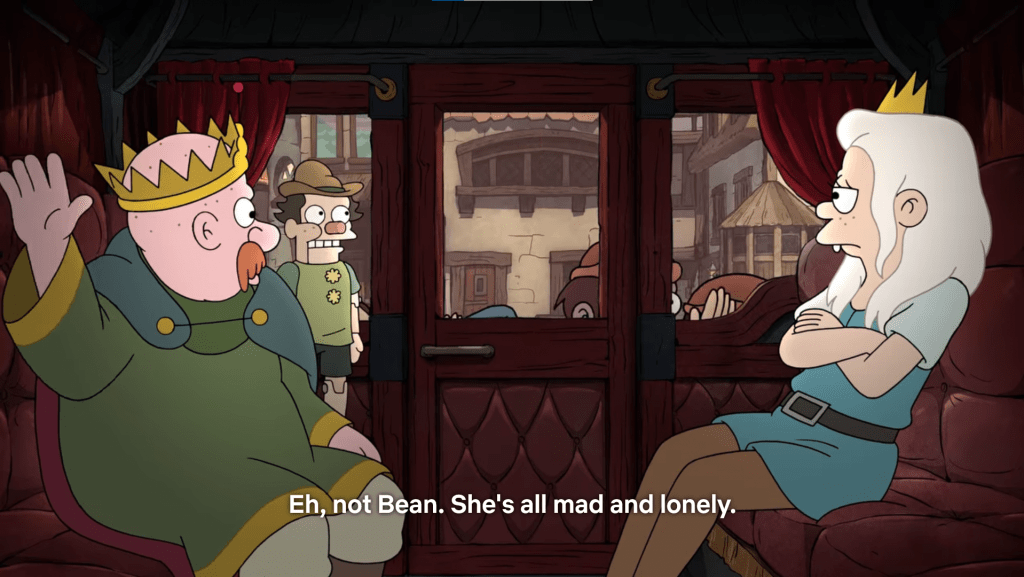
This reminds me of how Khepra paid off people to fight with her, and the show’s protagonist, Cleo, in Cleopatra in Space. Like Freckles, Khepra did this to gain her trust, while she was working with the villain the whole time. In Disenchantment, his efforts are for naught. The series ends with Dagmar and Satan in charge, willing to do anything to keep their power.
This series has a major focus on organized religion, just like gen:LOCK. There are places named “heaven” and “hell.” Luci appears in Heaven despite the fact he is a demon. God (voiced by Phil LaMarr) tells Jerry that God is everywhere, even in a toilet when people are taking a crap. He also says that the troubles of humans are for them to sort out, so he doesn’t intervene. Hell is a place that people can travel to with a scary elevator. On the one hand, the series depicts religion as restorative. Zog becomes more at peace with himself while in a monastery. On the other, it is a place of violence. Bean’s doppelganger kills her inside a church during one of her nightmares.
Organized religion is only one form of exploitation and oppression depicted in Part 4 of Disenchantment. Some episodes serve as commentary about trophy hunting, explorers, and zoos. In episode 7, explorers from the League of Gallivanting Scrutinators come in an airship from Steamland. They hope to catch game in the forest.
While they can’t capture the “right” animal, they still capture a “beast.” When a huge fire burns a huge swath of the forest after explorers speared Zog’s cigar rather than him, they leave and don’t look back.
In the final episode, Odval and Zog search for Derek, Jasper, and Freckles. They try and save them. Unfortunately, someone in Steamland kidnaps them for an exhibition, making them part of a supposed “freak show.”
Memories, dreams, and mental health
Like Inside Job, memories and dreams are a central part of Disenchantment. This begins with Freckles invading the dreams of Zog and Bean. He probes into the Zog’s repressed memories. This reveals hidden trauma. He hopes to turn Zog and Bean, who is 19 years old, against one another. This strategy is unsuccessful.
Episode 6 takes place almost exclusively in an underwater kingdom, Bean wants to atone to the sea trogs for what their ancestors did. This is after Zog reveals that humans took Dreamland from the elves. She finds out that the sea trogs put worms into people’s ears, mind-controlling them, a little like the brain worms in Star Wars: The Clone Wars. She barely escapes alive.
Throughout the last few episodes of Part 4, Bean begins to have recurring nightmares. She becomes so dedicated to stopping them that she cuts the rope to the elevator to hell. This causes causing Hansel and Gretel to plummet to their deaths! This is because she believes that the person in her dreams is her sadistic mother, Dagmar. When she drinks a special liquid, her nightmares become clearer. She then discovers something horrifying: the person she had been following is herself. It was an unexpected twist, for sure.
This makes for an exciting final episode. Bean debates her evil doppelganger, who she calls “Bad Bean.” She begins starts to trust and believe Bad Bean. Akin to Darth Sideous training Anakin Skywalker on how to concentrate his hatred, Bad Bean tells Bean that her electric powers only flow when she is angry. She riles her up, saying she should be furious at the “damn patriarchy” and the “whole system.” At one point, she taunts her by saying she knows what a mermaid kiss tastes like.
As it turns out, Bad Bean is a total snake. She does the switcheroo and traps Bean in her own dream. She only gets rescued with the help of her friends and is able to kill the Bad Bean. Although Bean does not defeat her sadistic mother, the series has an optimistic message.
Disenchantment seems to be saying that you can take control of your mind and body, and push out bad thoughts and attitudes. The series makes clear that everyone has a part inside them capable of great harm. This means that it is a struggle to keep that part of yourself in check.
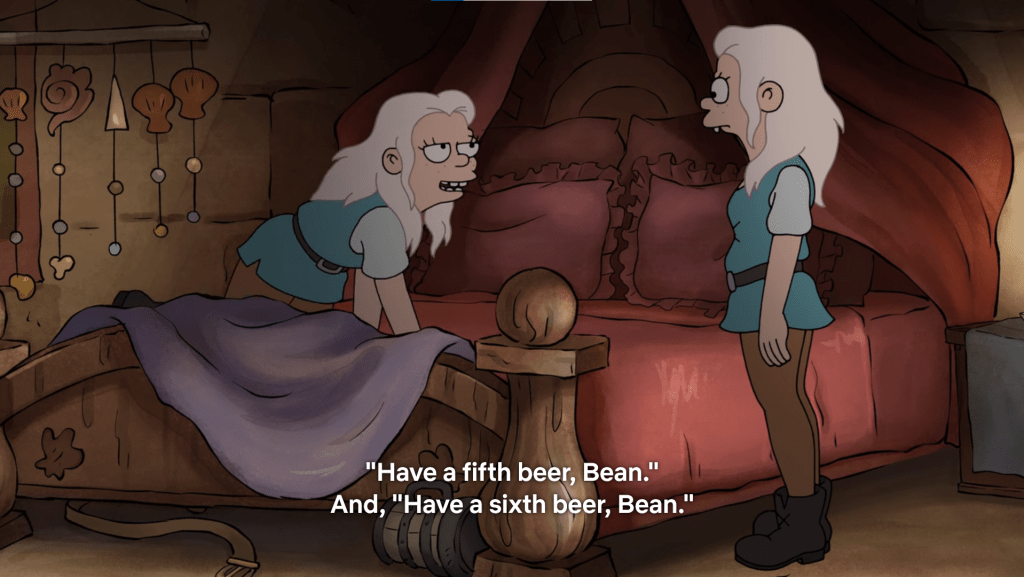
This connects to the show’s commentary on mental asylums. Early on in Part 4, Zog expresses his trauma from someone burying him alive during Part 3 and has “therapy sessions.” He even begins to speak normally, rather than honking, even to his fellow inmate, Giggles.
At one point, he tries to kill the therapist after the therapist declares he will stay there forever. Instead of the therapist facing consequences, they believe Zog is the one at fault. Zog is then taken away to a room and put in a straightjacket. The series seems to depict mental institutions as agents of oppression that engage in structural violence.
Chazzzzz (voiced by Herman), the practitioner who tortures people, works at the asylum. He is someone who enforces this structural violence onto Zog and other inmates. Luckily, Zog is able to flee and his loyal servants, Vip and Vap help him.
In these ways, the series has some similar themes to ND Stevenson’s Nimona. That webcomic, and later graphic novel, does a better job at showing structural violence than Disenchantment.
Romance and queer themes
Early this month, David Opie, TV editor for Digital Spy, tweeted that Part 4 of Disenchantment could have been “queerer this time round.” I have to agree. I say this as a person whose first review for The Geekiary was about Disenchantment parts 1-3. At the time, I argued that queerness in Disenchantment is “integrated into the show itself.” I noted the casual queerness, the gay relationship between Odval and Sorcerio, and the possible relationship between Big Jo and Porky. I pointed to Bean and Lady Bowmore crushing on one another, the love story between Mora and Bean, and that Bean is bisexual or pansexual.
I even said that the story is a step forward for Matt Groening, in terms of inclusive storytelling. I pointed to stereotypes in Futurama and the lack of strong queer representation among The Simpsons main cast. I have become a better writer and editor since then and I’m more critical of the series now than I was back then.
Romance is an important theme in Disenchantment. The series sends the message that love should be heartfelt rather than forced. Dagmar’s arranged marriage between Satan and Bean is portrayed negatively. Even the theme of their wedding is “love is hell” which is like how Greg Universe described love as “torture” to Rose Quartz in Steven Universe.
Although Bean’s mom puts her in leg irons and handcuffs, she still rebels. She gets Satan to dislike her and cuts Dagmar’s hand, so that she is the “Queen of Dreamland” on paper rather than her. This will likely have significance in future seasons. In other episodes, Zog reconnects with Ursula, learning he has another son named Jasper, a bear cub. He later bonds with his daughter, Bean, as well.
This interconnects with queer moments weaved throughout Part 4. In episode 4, Bean realizes what the audience already knew: her romance with the mermaid, Mora (voiced by Meredith Hagner), was real. In a later episode, Freckles refers to Bean’s romance with Mora to set her off. In another episode, Luci tells Bean that “pearls don’t go with your whole tomboy femme thing anyway.”
The first part of the phrase could refer to the term “pearl-clutch,” with gay men using it to mean a “sense of shock, surprise, and awed admiration.” Alternatively, it could be a reference to another related term: “pearl-clutching.” That is a charge often lobbed at women, accusing them of “not being liberal, or feminist, or open-minded enough.” The latter seems more likely than the former.
Luci’s use of the term “tomboy femme” likely refers to when someone plays with their gender presentation. It blurs the “lines between what it is to be purely on one side of the feminine to masculine spectrum.” This includes pairing designs seen as masculine with those seen as feminine.
Bean-Mora slow romance and other queer moments
Part 4 of Disenchantment continues the very slow romance between Bean and Mora. At the end of episode 6, Mora saves Bean, and she slips away, telling Bean, saying “damn it, I got to go.” As such, Bean doesn’t realize she was even there. In the following episode, she is defensive about who saved her. She wears the necklace Mora gave her but hides it.
At one point in Part 4, Bean admits to her father, Zog, that she is in love with Mora. He reveals to her that his first love was a mermaid, and adds that there is never a right time for love. Later, Bean avoids the pub and goes to the beach instead, believing she needs to “get over” Mora before it is “too late.”
In episode 8, one character tells Bean that his wife is bisexual. In the same episode, she has a nightmare with Mora telling her to wake up. In the final episode, Bean’s toxic, and controlling, mother, pushes her into the ocean. Once there, Mora pulls her close, with both kissing and embracing one another.
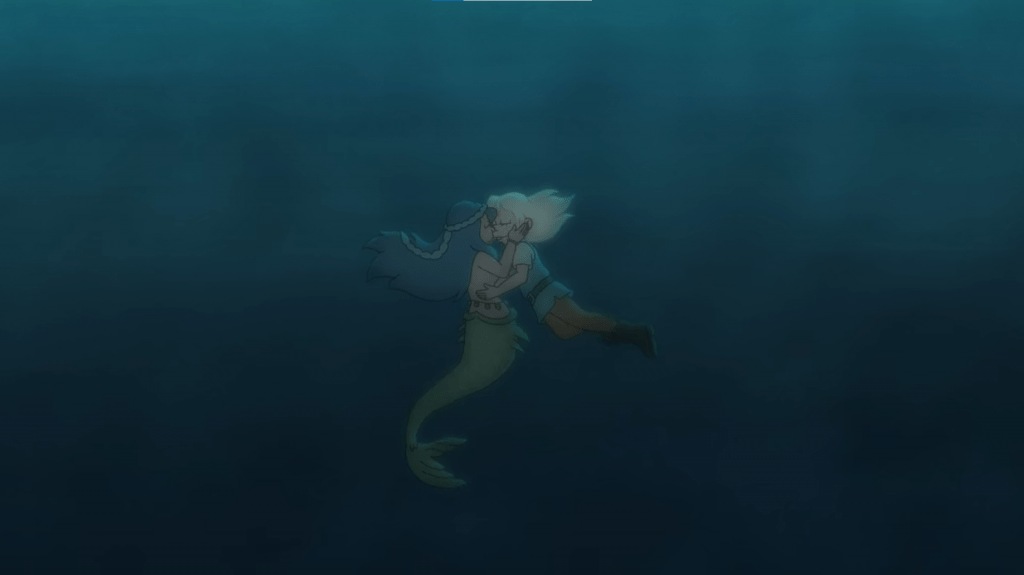
The slow romance leaves a lot to be desired. Fans are rightly happy at the Morabeanie moments in Part 4, and have posted beautiful fan art. Even the official Instagram account has posted Morabeanie fan art. The official Twitter account, when responding to a fan about Bean and Satan together, added “I think she has her eyes on someone else…,” hinting at Mora. Despite this, the moments Bean and Mora have together in the actual episodes are too far and few between.
The romance between Mora and Bean is, perhaps, better than the slow-moving romance between Vi and Caitlyn in Arcane. But, it seems like there was more time between Mora and Bean in Part 3 than in the recent episodes. There was a whole episode about it, “Last Splash.” In the episodes that followed, Bean reflected on what happened, believing that it was not real.
A major sub-theme of Part 4 of Disenchantment is Bean realizing she has feelings for Mora and trying to act on them. The plot focused more on Zog’s new son, Jasper, manipulative beings like Freckles, and other lore than Bean’s romance with Mora, or Mora’s feelings for Bean.
I wish there had been more “conversations about love, romance, and relationships” like those in the Part 3 episode, “Last Splash.” Both actresses adlibbed lines about romance in the episode. Hopefully, future episodes expand on the relationship between them, allowing Bean (and Mora) to be happy together. I’d like Bean to be more of a “messy queer.”
Other queer moments in the series were also minimal. For example, Odval and Sorcerio did not have many scenes where they experienced their time together. Furthermore, the series makes it clear that Jo and Porky are not a couple. Instead, Porky doesn’t mind when Jo is taken to the mental asylum, in place of Zog, and seems glad he is gone.
This means that the series is more likely saying that Jo and Porky have a toxic relationship. This is like some descriptions of the Gem fusion between Lapis Lazuli and Jasper in Steven Universe.
Bean, bisexuality, and pansexuality
Part 4 of Disenchantment hints that Bean is bisexual. For Bean, gender does not seem to be a barrier to attraction. She has kissed a male elf, Elfo, and a female mermaid, Mora, and had various male callers in the past.
Bean fulfills GLAAD’s definition of someone who is bi. This means someone who has the “capacity to form enduring physical, romantic, and/ or emotional attractions to those of the same gender or to those of another gender.” The organization also says that those who have “the capacity to be attracted to people of any gender” might consider themselves as part of the bi+ community, or use terms like pansexual, omnisexual, polysexual, and so on.
You could say that she is only attracted to those of specific genders, with gender as a factor in attraction. This is further supported by Netflix Geeked describing her as a “new bisexual icon” and voice actress, Jacobson, as a bisexual woman.
In Part 4, Bean said that she does not like labels. Some might guess that idea of pansexuality would draw her in. It has been described as a “sense of freedom” which validates the “fluidity of attraction…[with] no boundaries or limitations” by some people. You could argue that Bean is not limited by gender, sex, or gender identity in who she loves, and that she loves those of any gender. Even so, for those who are pansexual, there can still be “gendered elements” in a person’s attraction toward someone else.
Bean would likely not describe herself as “bisexual” or “pansexual.” The creators have not directly addressed Bean’s sexual orientation, just as Mike McMahan has not confirmed whether Beckett Mariner in Star Trek: Lower Decks is bisexual or pansexual.
Abbi Jacobson recently described her role in voicing Bean in a recent interview. Jacobson said that she has been voicing Bean since 2017. She said that is “changing with the character…grow[ing] and chang[ing] with them a little bit.” She called it “a huge gig,” saying she now feels “more confident with her” than in the past.
She described how she has a similar vibe to Bean. She remarked that Bean’s character development has included “Bean’s finding her sexuality and that part of herself.” She added that started to “lean toward” her in a way as a result, seeing even more similarities. Since Jacobson is one with the character and it is an inherent manifestation of her, it again confirms that Bean is bisexual.
Jacobson added that she feels the “seeking, searching part of her, and finding your people.” She argued that Elfo and Luci are her “chosen friends and found family,” which she relates to more than anything else.
Bean is not alone in this. Tamara in Star Wars Resistance and Reagan in Inside Job, both have chosen or found families of their own. Taken in this light, Disenchantment has a story that makes clear that “the ones who accept and love us aren’t always blood-related.”
Drama, fantasy, adventure, and satire
On February 9, 2022, Opie, tweeted that Part 4 was a mess, that the narrative is all over the place and said the jokes were “pretty sporadic.” He added that something about the show kept him watching.”
Opie has a valid point. The narrative of Disenchantment moves rapidly. Even so, it stays together as one story. At the same time, the narrative could be stronger. There are some “subplots that fall flat” as one reviewer put it.
Part 4 of Disenchantment emphasizes drama, fantasy, adventure, and satire more than comedy. There are some funny parts, like the scenes with Laughing Horse, Elfo chased by a boulder, and an elf admitting he writes “elf erotica.” There is some morbid humor. For example, Stan the executioner (voiced by Noel Fielding) admits that he killed a teacher because she was starting a teachers union.
The episodes are more serious than any of the other parts of the series. This tonal change may cause some to pull away from the series and not watch it. Even if this is the case, Part 4 is doing very well. New episodes are pulling in millions of viewers.
Despite the changed tone, family togetherness is a major theme. In Part 4, Elfo learns that his mother is an ogre named Grogda. She had sex with his dad, a traveling candy salesperson, and that they lived in the trees to hide from gnomes. But, this didn’t last. Their home was destroyed during a gnome attack. Elfo returned to Elfwood with his pop, while Grogda stayed on the outside. Later, he learns that Junior, a ogre he stabbed earlier in the series, is his half-brother. They agree to not fight one another, with Junior accidentally killing his stepfather.
In another episode, Luci tells Bean that Dagmar sees her not as a person but as an extension of herself. He suggests she stop focusing on revenge, anger, and wrath if she wants to break free. In other episodes, Derek and Jasper, who are Zog’s sons, take a dislike to each other at first. They later agree to work together. Both say they can hurt people better if they work together than if they are apart, with Elfo as their first victim.
Art, animation, lore, voice acting, writing, and beyond
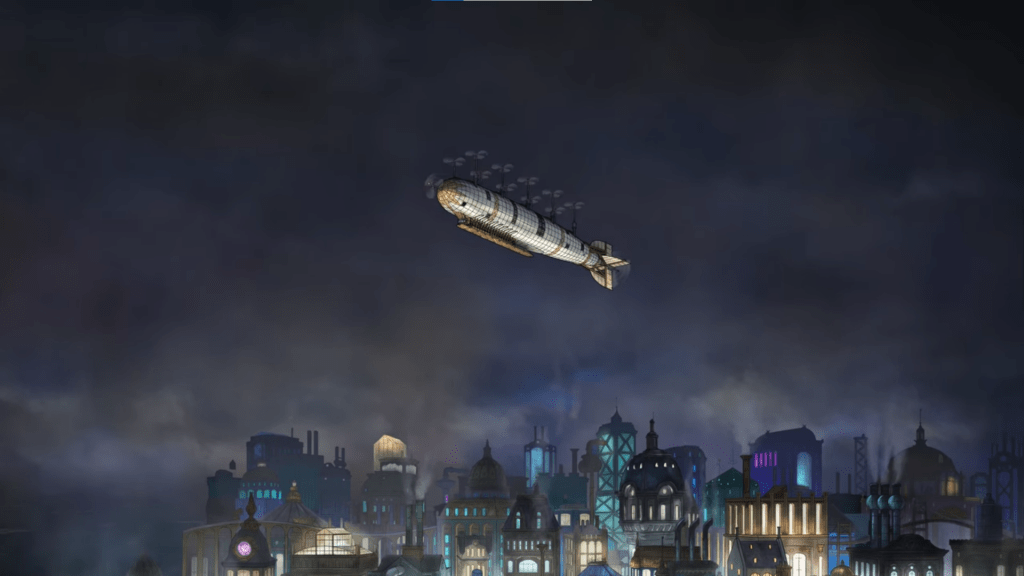
The background art and animation are superb. This includes the art of Steamland, the steam-powered steampunk city. It is one of my favorite locations in the series. It first appears in episode 2 when Bean, Luci, and Jerry stumble into an elevator from Hell. I found it fascinating that while Steamland is progressive on the surface, the steam which allows the city to run comes from Hell.
It was funny to see Alva Gunderson (voiced by Richard Ayoade) watching cartoons. I loved seeing the splendor of Steamland. I also loved seeing his invention, a steam-powered wheelchair, which he dubbed the “ass chariot.” The huge airship that Bean and her friends stole from him so they could get back to Dreamland, is a tremendous work of machinery and science. It is not immune from attack, however. In typical Disenchantment fashion, it is shot down, and Bean, and her friends, somehow escape.
The design of Steamland makes me think of the mix of medieval and modern in High Guardian Spice. Disenchantment is a series that does something similar, blending both together. Some fan fiction writers on Archive of Our Own even focused on Steamland in their stories. Apart from Steamland, the background art of the series remains amazing. The storyboarders, animators, and background artists have done a great job.
These episodes reveal a lot of lore. This begins with the elves attempting to find their legendary homeland which they believed was Dreamland. The airship from Steamland has settings like Dankmire, New Cremorium, Dullsville, Naked City, Twinkletown, and Oxnard.
Bean is shown to have magical powers of some type. She is even able to heal scratches on her father’s arm. In another episode, she touches a sword and it flashes her back to the battle in the cove. We also learn that the elves and trogs are interrelated.
One of the strongest parts of Disenchantment is the voice acting. This is evident in Part 4. Voice talents of Jacobson, Horgan, Fulcher, Faxon, Herman, DiMaggio, and Montgomery stand out, as does the voice acting for supporting and minor characters.
For instance, Mary (voiced by Lauren Tom), otherwise known as the mop girl, had a bigger part in this season. Oona (voiced by Tress MacNeille), the unnamed owner of a “freak show,” and Stan the executioner (voiced by Fielding) stood out as well.
Disenchantment‘s voice actors have appeared in animated series like Inside Job, Amphibia, Solar Opposites, The Great North, Housebroken, and Twelve Forever. This makes clear the strength of the show’s voice cast. While the cast is not very diverse, it includes voice actors like LaMarr, Andre, and Ayoade who are Black men.
The writers and directors of Part 4 episodes are a talented group of individuals. Of the eight episode directors, five directed Futurama episodes, and two worked on The Simpsons and Drawn Together. Others worked on Sym-Bionic Titan, Bob’s Burgers, and Rick and Morty. Only one, Ed Tadem, was new to animation directing and had not directed on any show previously.
Two directors, Crystal Chesney-Thompson and Edmund Fong, are part of Rough Draft Studios which is producing the series. The same studio produced the original Star Wars: Clone Wars series, seasons of Futurama and subsequent made-for-TV films.
The writers of Disenchantment Part 4 are similar. Of the show’s nine writers, four wrote for Futurama. The others wrote for Simpsons video games (Jamie Angell) and Bob’s Burgers (Jameel Saleem). One of the writers, Liz Suggs, has written for live-action series and is co-producer of an upcoming animated series, Wings of Fire.
Saleem, a Black man, has a production company of his own named Black Bear and Fluffy. Adam Briggs is an Indigenous Australian rapper. Abe Groening is the son of Matt Groening. This series appears to be the first writing credit for Abe Groening. As such, the show has some diversity in the writers room, but could still do better.
The music of Disenchantment fits with the story. It ties in with the opening sequence of each episode which previews what will happen in that episode. Mark Mothersbaugh is the series composer. He is the co-founder, keyboardist, and lead singer of Devo. He has worked on series such as Regular Show, Summer Camp Island, and Close Enough. As Groening described it, Mothersbaugh put together a “theme song that’s Eastern European brass band-klezmer with accordions and tubas”
Future of Disenchantment
Netflix will likely renew this animated series. Despite the fact that executives sometimes can make wild decisions and cancel shows, it is unlikely to happen with Disenchantment. After all, there is already nice fan merchandise and the show seems to be getting a lot of attention.
Although some vowed to stop watching the show because Andre is selling an edible NFT, it is extreme to boycott a show because of what one actor has done. For instance, I could stop watching Young Justice because Greg Cipes (who voiced Beast Boy) digests and expels crypto-babble. If I decided to boycott it because of Cipes, I would miss out on stories featuring Halo/Violet (voiced by Zehra Fazal), a genderqueer character, and my favorite in the whole series.
Apart from the obvious continuation of the Bean-Mora romance, future stories could focus on Bean’s possible ancestor, characters who were absent from Part 4 episodes, and Bean’s attempt to retake the throne. That’s only some of the many storylines for possible Parts 5 and 6.
The show could be under strain because Futurama is coming back for an eighth season in 2023 on Hulu. The return has been controversial because DiMaggio, who voices Bender, has not agreed to come back. This has led some to say that they would not watch the series unless he returns.
Even so, there is a possibility of a crossover. Disenchantment references Futurama various times. This includes a reference to the Futurama episode “Devil’s Things Are Idle Playthings,” Doctor Zoidberg, Futurama comics, and Enos Fry.
The creators of Disenchantment will be pushing for another season. A new season may be announced in the next few months and released sometime in February 2023 or March 2023. In February 2021, Josh Weinstein, one of the showrunners, said that if Netflix renewed Disenchantment, there would be two more 10-episode parts before the story came to an end.
In the end, Disenchantment deserves a watch for its queer content, strong voice acting, storytelling, art, animation, writing, music, and focus on mental health. Disenchantment is currently streaming on Netflix.
Author: Burkely Hermann
Burkely is an indexer of declassified documents by day and a fan fic writer by night. He recently earned a MLIS with a concentration in Digital Curation from the University of Maryland. He currently voraciously watches animated series and reads too many webcomics to count on Webtoon. He loves swimming, hiking, and searching his family roots in his spare time.
Help support independent journalism. Subscribe to our Patreon.
Copyright © The Geekiary
Do not copy our content in whole to other websites. If you are reading this anywhere besides TheGeekiary.com, it has been stolen.Read our



